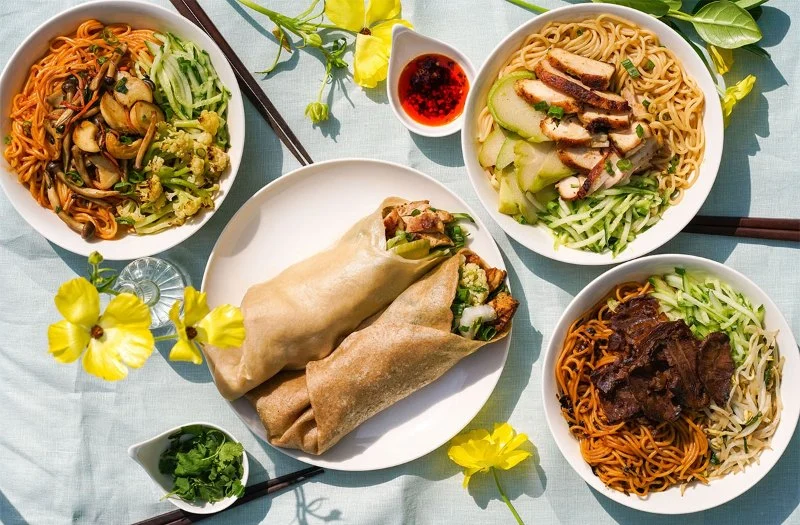
- 1. The Rise of Fusion Cuisine
- 2. Combining Traditional Asian Flavors with Modern Trends
- 3. Notable Examples of Asian Fusion Restaurants
- 4. How Global Ingredients Are Influencing Asian Dishes
- 5. The Future of Asian Cuisine: Innovations and Trends
1. The Rise of Fusion Cuisine
In recent years, fusion cuisine has become one of the most popular dining trends around the world. One of the most notable examples of this is the fusion of traditional Asian flavors with contemporary global culinary trends. Asian restaurants are embracing this change by mixing long-standing cultural recipes with new techniques, flavors, and ingredients from various global culinary traditions. This exciting development is not only changing the way we experience traditional dishes but also reshaping the global food landscape.

Las Americas Bakery / las americas bakery
93-04A 37th Ave, Jackson Heights, NY 11372, USA
2. Combining Traditional Asian Flavors with Modern Trends
Asian cuisine is diverse, and each country has its own set of culinary traditions. The real innovation happening today in many Asian restaurants is how they are merging these rich, traditional flavors with global influences. From using French techniques in Chinese cuisine to incorporating American barbecue elements into Japanese food, chefs are experimenting with new ways to create exciting flavors.
- Classic Ingredients Meet Modern Methods: For example, sushi rolls may feature unexpected ingredients like avocado, or they might be grilled instead of raw. These small changes can breathe new life into a traditional dish.
- Global Flavors in Traditional Dishes: Chinese food, long known for its bold flavors, might now be paired with spices from the Middle East, while Korean BBQ may include South American-style marinades. The possibilities are endless.
3. Notable Examples of Asian Fusion Restaurants
Several Asian restaurants are leading the charge in combining traditional flavors with global trends. These establishments showcase how chefs are boldly experimenting with ingredients and cooking methods from around the world. Let’s look at a few examples:
- Momofuku: Chef David Chang’s Momofuku is a pioneer in Asian fusion cuisine. Known for reinventing traditional dishes, Chang blends Korean and Japanese influences with Western ingredients, like using pork belly in ramen, a modern twist on the classic dish.
- Roy Choi’s Kogi BBQ: The Kogi BBQ food trucks revolutionized Asian fusion by blending Korean BBQ with Mexican street food, creating the iconic Korean BBQ taco. This fusion became a hit and continues to inspire chefs everywhere.
- Sushi Samba: This innovative restaurant combines the flavors of Japan, Brazil, and Peru. Its sushi features tropical fruits, ceviche, and Brazilian spices, showcasing the vast potential of global flavor combinations.
4. How Global Ingredients Are Influencing Asian Dishes
One of the key factors driving this trend is the incorporation of global ingredients into traditional Asian dishes. As more exotic and local ingredients from different parts of the world become available, Asian chefs are using them to reinvent their menus:
- Using Herbs and Spices: Ingredients like fresh cilantro, kaffir lime, and even saffron, which are not traditionally found in Asian dishes, are being used to elevate flavors in everything from stir-fries to noodle soups.
- Innovative Pairings: Unique combinations such as lemongrass with chili or miso with truffle oil are pushing the boundaries of traditional taste profiles.
- Fusion Desserts: Asian-inspired desserts are also seeing a twist. For example, green tea ice cream might be paired with a Mexican chocolate chili sauce, or a Japanese mochi might be stuffed with Mediterranean ingredients like pistachios.
5. The Future of Asian Cuisine: Innovations and Trends
As the global food scene continues to evolve, the fusion of traditional Asian flavors with global trends will undoubtedly continue to grow. Asian restaurants will keep experimenting with new ingredients, techniques, and food pairings, reflecting the increasing globalization of food culture. Here are a few trends to watch for:
- Sustainable Ingredients: Many Asian chefs are focusing on sustainable food practices, using local and seasonal ingredients to minimize their environmental footprint while maintaining the rich, bold flavors traditional to their cuisines.
- Health-Conscious Dishes: As health-conscious eating continues to rise, we may see even more health-focused innovations in Asian fusion food. Expect to see more plant-based ingredients, low-sugar alternatives, and gluten-free options.
- Continued Exploration of Global Flavors: As chefs continue to travel and explore new global flavors, we can anticipate even more adventurous and unexpected combinations in the future.







 McDonald's4.0 (1227 reviews)
McDonald's4.0 (1227 reviews) Acro Coffee4.0 (97 reviews)
Acro Coffee4.0 (97 reviews) The Gramercy4.0 (349 reviews)
The Gramercy4.0 (349 reviews) Sahola Coffee4.0 (143 reviews)
Sahola Coffee4.0 (143 reviews) Bareburger4.0 (2933 reviews)
Bareburger4.0 (2933 reviews) Tacos La Broadway3.0 (14 reviews)
Tacos La Broadway3.0 (14 reviews) Discover the Best American Restaurants That Highlight Regional Specialties
Discover the Best American Restaurants That Highlight Regional Specialties How Seafood Restaurants Are Combining Traditional Recipes With Contemporary Style
How Seafood Restaurants Are Combining Traditional Recipes With Contemporary Style The Rise of Breakfast Restaurants Offering Unique Global Dishes
The Rise of Breakfast Restaurants Offering Unique Global Dishes How Coffee Shops Are Experimenting With New Brewing Methods
How Coffee Shops Are Experimenting With New Brewing Methods How Mediterranean Restaurants Are Creating Seasonal Menus That Celebrate Freshness
How Mediterranean Restaurants Are Creating Seasonal Menus That Celebrate Freshness Discovering the Best Buffet Restaurants for Family Dining
Discovering the Best Buffet Restaurants for Family Dining